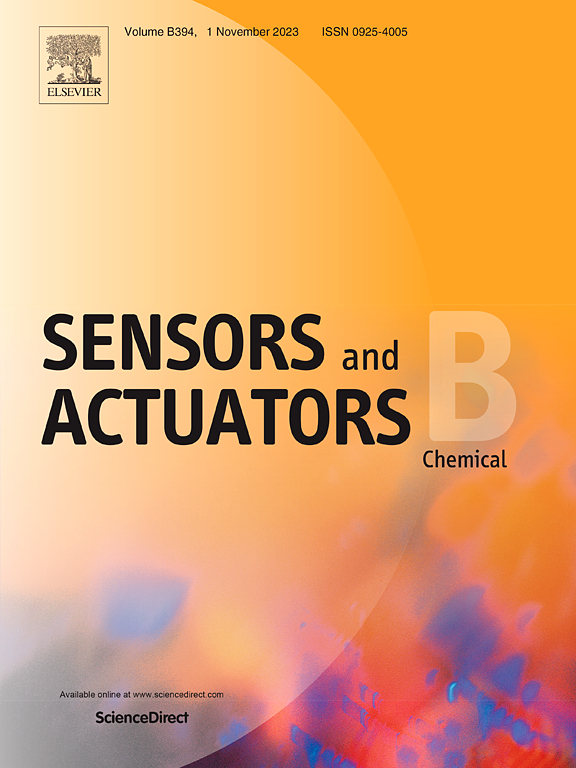基于DNAzyme和碳点的牛奶中β-乳球蛋白的比色和荧光双模式生物传感器
IF 8
1区 化学
Q1 CHEMISTRY, ANALYTICAL
引用次数: 0
摘要
乳球蛋白(β-Lactoglobulin, BLG)是牛奶中的一种主要过敏原,已被证明是评价牛奶质量的重要生物标志物。本文首先构建了一种基于g -四联体/血红蛋白DNAzyme和橙色发射碳点(O-CDs)的比色和荧光双模生物传感器,用于检测BLG。利用BLG适体生成g -四联体/血红蛋白DNAzyme,其具有过氧化物酶样(pod样)活性,可作为特异性识别探针。DNAzyme有效催化3,3 ',5,5 ' -四甲基联苯胺(TMB)转化为其蓝色氧化产物(oxTMB),同时通过内部过滤效应(IFE)猝灭O-CDs的荧光。当BLG存在时,适体特异性地与BLG结合,从而破坏DNAzyme的结构。因此,DNAzyme的pod样活性降低,导致oxTMB的产生受到抑制,O-CDs的荧光恢复。通过观察oxTMB在370 nm处的比色信号变化和O-CDs在580 nm处的荧光信号变化,可以准确测定BLG。所开发的生物传感器在1 μg·mL−1至500 μg·mL−1的浓度范围内具有良好的线性。与智能手机平台集成,无需仪器即可实现便捷的定量分析,满足即时护理检测(POCT)的要求。这项研究对确保粮食安全具有重大潜力。本文章由计算机程序翻译,如有差异,请以英文原文为准。
A colorimetric and fluorometric dual-mode biosensor for point-of-care testing of β-lactoglobulin in milk based on DNAzyme and carbon dots
β-Lactoglobulin (BLG) is a major allergen in milk and has proven to be a valuable biomarker for the assessment of milk quality. Herein, a colorimetric and fluorometric dual-mode biosensor was first constructed for detecting BLG based on the G-quadruplex/hemin DNAzyme and orange-emitting carbon dots (O-CDs). The BLG aptamer was employed to generate G-quadruplex/hemin DNAzyme, which exhibits peroxidase-like (POD-like) activity and serves as a specific recognition probe. The DNAzyme efficiently catalyzes the conversion of 3,3′,5,5′-Tetramethylbenzidine (TMB) into its blue oxidation product (oxTMB) and simultaneously quenches the fluorescence of O-CDs through the internal filter effect (IFE). Upon the presence of BLG, the aptamer specifically binds to BLG, thereby destroying the structure of the DNAzyme. Consequently, the POD-like activity of the DNAzyme is decreased, leading to an inhibition of oxTMB production and a restoration of the fluorescence of O-CDs. The BLG can be accurately measured by observing the changes in the colorimetric signal of oxTMB at 370 nm and the fluorescence signal of O-CDs at 580 nm. The developed biosensor demonstrates excellent linearity over a concentration range spanning from 1 μg·mL−1 to 500 μg·mL−1. Integrated with the smartphone platform, it could realize convenient quantitative analysis without instruments and meet the requirements of point-of-care testing (POCT). This study holds significant potential for ensuring food security.
求助全文
通过发布文献求助,成功后即可免费获取论文全文。
去求助
来源期刊

Sensors and Actuators B: Chemical
工程技术-电化学
CiteScore
14.60
自引率
11.90%
发文量
1776
审稿时长
3.2 months
期刊介绍:
Sensors & Actuators, B: Chemical is an international journal focused on the research and development of chemical transducers. It covers chemical sensors and biosensors, chemical actuators, and analytical microsystems. The journal is interdisciplinary, aiming to publish original works showcasing substantial advancements beyond the current state of the art in these fields, with practical applicability to solving meaningful analytical problems. Review articles are accepted by invitation from an Editor of the journal.
 求助内容:
求助内容: 应助结果提醒方式:
应助结果提醒方式:


